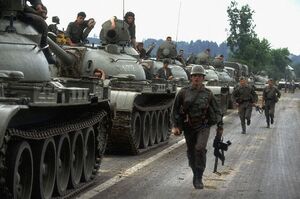The Slovenian Independence War (Slovene: Slovenska osamosvojitvena vojna) sometimes called the Ten-Day War (Slovene: Desetdnevna vojna) , was a brief military conflict between Slovenian TO (Slovenian Territorial Defence) and the Yugoslav People's Army (JNA) in 1991 following Slovenia's declaration of independence.

Background[]
Following the death of Yugoslav president Josip Broz Tito in 1980, underlying political, ethnic, religious, and economic tensions within Yugoslavia surfaced.
In 1989 Slobodan Milošević, Chairman of the Central Committee of the League of Communists of Serbia since 1986, became president of Serbia, the largest and most populous of the six Yugoslav republics. In April 1990, Slovenia held its first democratic multi-party elections, won by the DEMOS coalition.
Preparations for war[]
On 23 December 1990, Slovenia held a referendum, which passed with 96% votes in favor of independence, with a turnout of 92%. The Slovenian government was well aware that the federal government in Belgrade might seek to use military force to quash Slovenia's move towards independence. Immediately after the Slovenian elections, the Yugoslav People's Army (JNA) announced a new defence doctrine that would apply across the country. The Tito-era doctrine of "General People's Defence", in which each republic maintained a Territorial Defence Force (Teritorialna obramba or TO), was to be replaced by a centrally-directed system of defence. The republics would lose their role in defence matters, and their TOs would be disarmed and subordinated to JNA headquarters in Belgrade.
The Slovenian government resisted these moves, and successfully ensured that the majority of Slovenian Territorial Defence equipment was kept out of the hands of the JNA. It also declared in a constitutional amendment passed on 28 September 1990 that its TO would be under the sole command of the Slovenian government. At the same time, the Slovenian government set up a secret alternative command structure, known as the Manoeuvre Structures of National Protection (Manevrska struktura narodne zaščite, or MSNZ). This was an existing but antiquated institution, unique to Slovenia, which was intended to enable the republic to form an ad hoc defence structure, akin to a Home Guard. It was of negligible importance prior to 1990, with antiquated weapons and few members. However, the DEMOS-led government realised that the MSNZ could be adapted to provide a parallel organisation to the TO that would be entirely in the hands of the Slovenian government.
When the JNA tried to take control of the Slovenian Territorial Defence (TO), the TO's command structure was simply replaced by that of the parallel MSNZ. Between May and October 1990, some 21,000 Slovenian Territorial Defence and police personnel were secretly mobilised into the MSNZ command structure, of which the federal government was wholly unaware. The Slovenian government also undertook detailed planning of a military campaign against the JNA, which resulted in the production of an operational and tactical plan by November 1990 — over seven months before the conflict actually began.
The Slovenes were aware that they would not be able to deter the JNA forces for an extended period of time. Under Defence Minister Janez Janša, they adopted a strategy based on an asymmetric warfare approach. TO units would carry out a guerrilla campaign, using anti-tank weapons and anti-aircraft missiles to ambush JNA units. Tank columns could be trapped by destroying the lead and rear vehicles in favourable terrain — for instance, on a narrow mountain road where room for manoeuvre was limited – enabling the rest to be tackled more easily. In preparation for this, the Slovenian government covertly bought lightweight missile systems from foreign suppliers, notably the SA-7 Grail (Strela) anti-aircraft missile and the German-designed Armbrust anti-tank system. Hit-and-run and delaying tactics were to be preferred and frontal clashes were to be avoided since in such situations the JNA's superior firepower would have been very difficult to overcome.
On the diplomatic front, neither the European Community nor the United States were willing to recognise the independence of Slovenia and strongly advocated the continuation of a unified Yugoslavia[citation needed]. The Slovenian government sought international assistance in negotiating a peaceful breakup of Yugoslavia but was rebuffed by Western countries that said they preferred to deal with a single federation rather than numerous small states. However, the Slovenes contended that they had no choice in pushing for independence, given a perceived lack of commitment to democratic values on the part of the Belgrade authorities.